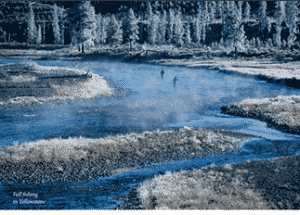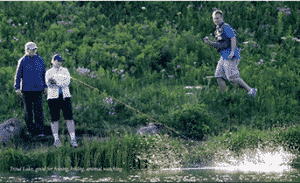Yellowstone Fly Fishing
Let me first say that I am not a hardcore fly fisherman. Sometimes I spin fish and other times I fly fish. Every spot I have mentioned is special and I have in no way listed every special fishing spot in Yellowstone. There are many great books on fishing Yellowstone. I would recommend Fishing Yellowstone National Park by Richard Parks. Parks Fly Shop, located in Gardiner, is a good source for fishing supplies and information. The most important thing to know about fishing Yellowstone is that once the spring snow starts to melt, most streams will not be fishable until the melt ends in late June or early July and the muddy waters clear. In some streams, the average number of times a fish is caught exceeds 8 per year. So, pinch all barbs on your fishing lure/flys and cut 2 hooks off any treble hooks you have. Everyone over 11 years of age will need to get a fishing permit. While you are not allowed to keep native fish that you catch, you can keep, and are actually required to kill, some non-native species. While not overly complicated, the fishing regulations are too involved to list in the Best Little Guide Book of Yellowstone, because, if I did, this book would not be little! Park fishing regulations can be had at most park entrances or visitor centers.
“If there was a guarantee that you were going to catch fish, fishing would be called catching and not fishing.” Now get fishing!
Fishing Near The Road
Soda Butte Creek and the Lamar River are part of the same drainage basin. Cutthroats abound from approximately June 20 (after the spring melt slows) until the Yellowstone fishing seasons ends on October 31. To be on one of these rivers when you have a 50 fish outing is unforgettable. My good friend Jake and I have had a few of those days and I hope to have a few more with Jake before… You will most likely only catch cutthroat trout on these rivers. The usual size is around 14 inches and at times 20 inches.
Gardner River is “best” when the

Brown trout run (spawn). The run starts in mid- September and lasts till the end of October, with the most productive fishing during the last two weeks of October. When you hook one of those hooked-beaked 18 or 20 inch browns and they spend more time dancing on top of the water than in the water, you may think that you have died and gone to fishing heaven. But when the teeth of that big brown trout slice into my finger as I am removing the lure, I quickly come back to earth.
I have spent many a day fishing the Gardner River making my way upstream from the parking lot at the Montana/Wyoming state line until I get to the Boiling River Hot Springs where I soak. See the “Best of Yellowstone” section for a description of Boiling River.
Backcountry Fishing
Slough Creek is as beautiful a fishing spot as there is. You can walk there or hire an outfitter to take you there on horseback. The Cooke City Chamber at www.cookecitychamber.org/ has listings for outfitters. There are 3 meadows along the creek. The “best” fishing is usually in the third meadow which may be the “best” spot in the park for catching large numbers of large fish. See hiking section for trail description and directions.
Agate Creek is a 7 mile hike, with steady gain of 1200 feet in elevation before dropping 1200 feet into the Grand Canyon of the Yellowstone. There should be plenty of 12 to 14'' Yellowstone cutthroat trout waiting for you. I fish in the Yellowstone River downstream from Agate Creek not the creek itself. Start at the Specimen Ridge trailhead located near the glacier interpretive pull-off, about a 1.5 mile to the east of Tower Junction. This hike has large gains and drops in elevation. You will definitely need to be in good shape and have a good topo map. There is a designated camping spot near the river and of course a backcountry permit is required if you spend the night. Don’t plan on eating any fish here; there are only native cutthroat trout on this section of the river. You will need to get an early start if you are just fishing.
Lewis Channel, the channel that flows between Shoshone Lake and Lewis Lake, is spectacular during the fall run of the brown trout. Many of the fish are over 20 inches. There are very, very large lake trout in Shoshone Lake feeding on the very large browns. Speaking from experience, you will need a heavy weight line to land one of these large lake trout. All I have ever managed to do is hook one of these lake trout, only to have the fish break my line over and over again. The run starts in early October and gets better the later in October that you go. I always fish near the outlet of Shoshone Lake, and I take the Dogshead trailhead off of HWY 89 to reach this fishing spot. There is a nice multi-site camping spot near the outlet. I have heard the call of loons from here in the evening. I hope you hear them too.
The Thoroughfare section of the Yellowstone requires a multi-day commitment and of course comes with no guarantees. But if you find the fish, they will probably be huge. A few years back, while fishing with some friends, I landed a 24" cutthroat. Next to me, in the same fishing hole, I watched my friend Bob hook a large fish 4 times, only to have the fish break his line each time. Having just landed the biggest cutthroat I had ever caught and wanting to wander around, I went exploring up stream. When I returned, Bob informed me that on his sixth attempt, he was successful at landing a 28'' cutthroat trout. Bob got his fish and I had one more fishing story to tell. See the hiking section for trail details and directions.

